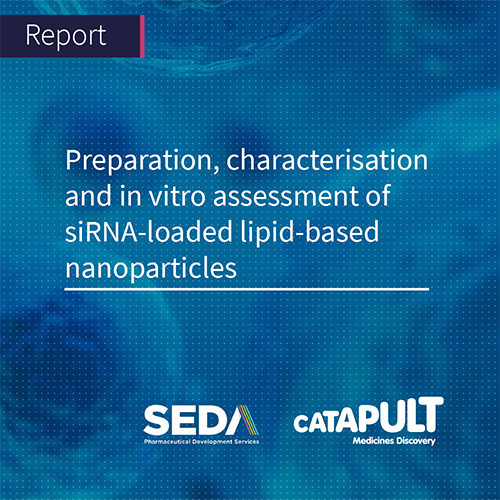Report: Preparation, Characterisation and in vitro Assessment of siRNA-loaded Lipid-Based Nanoparticles

Scope
This paper demonstrates the combined in vitro capabilities of Seda Pharmaceutical Development Services in the manufacture and physical characterisation of lipid-based nanoparticles for nucleic acid delivery, coupled with the advanced in vitro characterisation capabilities of Medicines Discovery Catapult (MDC). Together, these organisations can support the design, prototype manufacture and screening of complex medicines ready for progression to preclinical in vivo testing and onwards to clinical development.
Introduction
In recent years, nucleic acid (NA)-based medicines have emerged as a promising new biotherapeutic modality, with the potential to target proteins considered ‘undruggable’ by small molecules. These medicines could revolutionise the treatment of genetic disorders, infectious diseases and even some types of cancer. There is a growing number of NA therapies that have been approved for clinical use and the market is forecast to reach USD 9.54 billion globally by 2028 (estimated by Mordor Intelligence)1. This recent increase has been significantly influenced by the success and the FDA approval of ONPATTRO® in 2018, and the SARS-CoV-2 lipid nanoparticle (LNP) vaccines in 2021 which deliver siRNA and mRNA, respectively. This has resulted in an increase in the number of SMEs and larger pharmaceutical companies investing in the development of NA medicines. RNA-based medicines (siRNA, mRNA and some antisense oligonucleotides) use RNA molecules to modulate the expression of specific genes. However, to be efficacious both in vitro and in vivo, they require a stable carrier. The development of suitable drug delivery vectors is therefore critical to realise therapeutic potential. To date, LNPs are the most clinically advanced, non-viral NA delivery tool.
The role of the drug delivery system is to: 1) protect the NA cargo from degradation by RNAses in the serum, 2) prevent unwanted patient immunogenicity and off-target effects driven by exposure to naked NAs, and 3) facilitate cellular trafficking (uptake and endosomal escape) and cytoplasmic delivery of cargo. Once the vector, with its NA cargo, has successfully crossed the relevant biological barriers, the intact cargo must be released at an appropriate concentration to exert the desired therapeutic effect.
Characterising the physical properties and biological function of nanoparticles (NPs) is critical for translation to the clinic. Key Physical criteria include a particle size of 200nm or less (typically closer to 100nm), a narrow size distribution, high encapsulation efficiency, and appropriate surface charge at physiological pH to balance both safety and efficacy. In terms of biological requirements, particles must have the capacity to internalise via direct fusion with the plasma membrane or endocytosis-mediated uptake (e.g. clathrin, dynamin, caveolin dependent and micropinocytosis), escape from a trafficking vesicle and efficiently deliver the cargo into the cell cytoplasm. Additionally, the development of robust and scalable manufacturing processes capable of ensuring product quality that meet regulatory requirements is essential. Comparability of LNP critical quality attributes across batches used in preclinical and clinical studies is also required.
Read the full report here: Preparation, characterisation and in vitro assessment of siRNA-loaded lipid-based nanoparticles





















